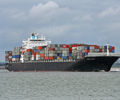World Trade at Sea Has Hangover From Party That Never Happened

Little more than a year ago, shipping companies hauling everything from furniture to electronics across the world’s oceans were looking forward to a period of surging demand. It didn’t work out that way and they’re still suffering now.
Seaborne trade, measured by the industry in 20-foot steel boxes, was meant to expand 7 percent to 182.1 million units, the strongest growth in four years, Clarkson Plc was anticipating at the end of 2014. The actual increase turned out to be less than half that amid weakening global growth, according to the world’s largest shipbroker. With fleet capacity also swelling, rates for the ships have slumped.
“Right now it’s difficult to see the light,” said Casper Blom, an analyst at ABG Sundal Collier Holding ASA in Copenhagen. “Even though we’ve turned the calendar into 2016 you still have this problem of overcapacity, it doesn’t just disappear.”
January saw the worst start to a year for container ship earnings for three years. Vessels returned just $5,957 a day on average, according to Clarkson. The average between 2010 and 2014 was $7,712.
Many of the world’s busiest container shipping routes are suffering from the slowdown in emerging markets and weak growth in Europe. China’s economy grew at 6.9 percent last year, the slowest since 1990. Europe’s predicted 1.5 percent expansion in 2015 would be among the weakest globally.
If the Chrysler Building could float, its size would rival that of the Morten Maersk, one of the largest cargo ships ever built.
A weakening in Asian and European growth means fewer exports on the trade route between the two continents, one of the industry’s most important sources of demand. With emerging market economies not expected to pick up any time soon and plentiful fleet supply, the situation may not turn around in this year, according to Blom.
The pressure on returns for container ships is being felt by some of the industry’s biggest companies. A.P. Moeller-Maersk A/S reported an 84 percent plunge in 2015 profit after its container division was squeezed by the oversupply of ships. Results of other container liner operators including Evergreen Marine Corp., Mitsui O.S.K. Lines and Orient Overseas International Ltd. are likely to reflect the same market conditions, according to Bloomberg Intelligence analysts Lee Klaskow and Talon Custer.
Maersk’s shares rose as much as 7.2 percent to 7,940 kroner in Copenhagen. They were at 7,920 kroner at 3:19 p.m. London time.
As well as an expectation of additional supply, few ships appear to be leaving the fleet. The number demolished in January was the lowest figure for the first month of the year since 2012, Clarkson data show.
“The problem is that there are also vessels coming into the market here in 2016 and demand isn’t looking much better,” Blom said.
HEADLINES
- Do shipping markets want Biden or Trump for the win?
- All 18 crew safe after fire on Japanese-owned tanker off Singapore
- Singapore launching $44m co-investment initiative for maritime tech start-ups
- Cosco debuts Global Shipping Industry Chain Cooperation Initiative
- US warns of more shipping sanctions
- China continues seaport consolidation as Dalian offer goes unconditional